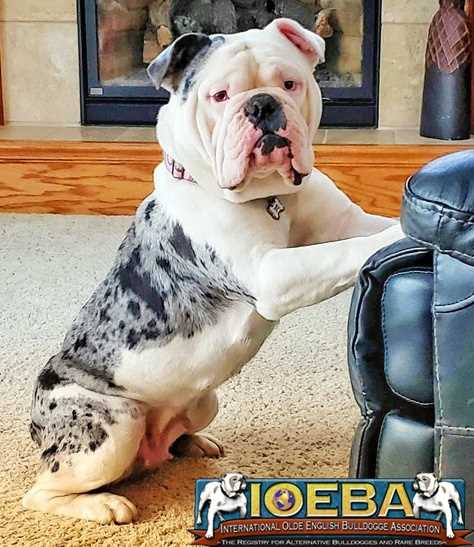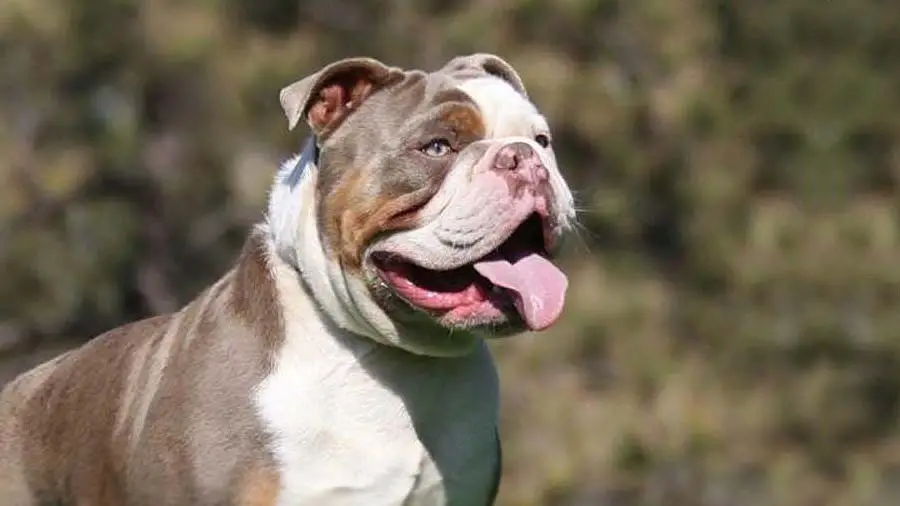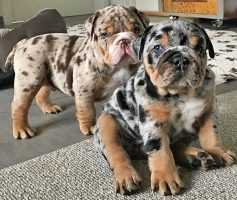
If you’re looking for a unique and eye-catching bulldog breed, then the Merle Olde English Bulldog might be just what you’re looking for. With its striking coat pattern and distinctive appearance, this breed is sure to turn heads wherever it goes.
The Merle Olde English Bulldog is a relatively new breed that has gained popularity in recent years. It is a cross between the Olde English Bulldogge and a Merle-colored dog, such as a Great Dane or a Dalmatian. The result is a dog with a muscular build, a broad chest, and a strong, powerful stance.
One of the most unique features of the Merle Olde English Bulldog is its coat pattern. The Merle gene causes a marbled or mottled pattern of colors, which can range from blue or gray to red or brown. This pattern is often accompanied by patches of solid color, giving the dog a truly distinctive look.
Despite its striking appearance, the Merle Olde English Bulldog is known for its friendly and affectionate nature. It is a loyal and devoted companion, and it gets along well with children and other pets. This breed is also intelligent and trainable, making it a great choice for families who are looking for a dog that is both beautiful and easy to train.
Overview of Merle Olde English Bulldog
The Merle Olde English Bulldog is a unique and beautiful breed that has gained popularity in recent years. This breed is a variant of the Olde English Bulldogge, which is known for its muscular build and friendly temperament.
Characteristics

The Merle Olde English Bulldog is a medium-sized dog with a strong and athletic build. They have a broad chest, muscular shoulders, and a powerful jaw. Their coat is short and dense, and they come in a variety of colors, including merle, which is a pattern of dark patches on a lighter background.
These dogs have a friendly and outgoing personality. They are known for being good with children and other pets, and they are often described as loyal and protective. They are intelligent and eager to please, which makes them relatively easy to train.
Appearance
The Merle Olde English Bulldog has a distinctive appearance that sets it apart from other breeds. They have a broad head with a wrinkled forehead and a short muzzle. Their eyes are round and expressive, and their ears are typically small and folded over. They have a thick neck and a muscular body, with a deep chest and a strong back. Their tail is usually docked, and their legs are short and sturdy.
One of the most striking features of the Merle Olde English Bulldog is their coat. The merle pattern is caused by a gene mutation that results in patches of color on a lighter base coat. The patches can be any color, including blue, chocolate, or fawn, and they can be of different sizes and shapes. This unique coat pattern makes the Merle Olde English Bulldog stand out and is one of the reasons why they are so popular.
Temperament
The Merle Olde English Bulldog is known for its friendly and gentle temperament. They are loyal and affectionate towards their owners and are generally good with children and other pets. However, they can be protective of their family and may be wary of strangers. Early socialization and training are important to ensure that they grow up to be well-rounded and well-behaved dogs.
These dogs are intelligent and eager to please, which makes them relatively easy to train. They respond well to positive reinforcement techniques and enjoy learning new things. They also have a moderate energy level and require regular exercise to keep them happy and healthy.
History

The Merle Olde English Bulldog is a relatively new breed that was developed in the late 20th century. It is a variant of the Olde English Bulldogge, which was created in the 1970s by David Leavitt. The goal was to recreate the original English Bulldog, which had become extinct in the 19th century.
The Merle Olde English Bulldog was created by introducing the merle gene into the Olde English Bulldogge breeding program. The merle gene is responsible for the unique coat pattern seen in these dogs. The breed has gained popularity in recent years due to its distinctive appearance and friendly temperament.
Origins
The Merle Olde English Bulldog has its origins in the United States. It was developed by breeding Olde English Bulldogges with dogs that carried the merle gene. The merle gene is not commonly found in the English Bulldog breed, so it was necessary to introduce it from other breeds, such as the Australian Shepherd and the Catahoula Leopard Dog.
By selectively breeding dogs with the merle gene, breeders were able to create a consistent and recognizable coat pattern in the offspring. The result is the Merle Olde English Bulldog, a breed that combines the distinctive appearance of the merle coat with the muscular build and friendly temperament of the Olde English Bulldogge.
Recognition

The Merle Olde English Bulldog is not currently recognized by major kennel clubs, such as the American Kennel Club (AKC) or the United Kennel Club (UKC). However, there are several breed-specific organizations that recognize and promote the breed, such as the Merle Bulldog Association and the International Olde English Bulldogge Association.
These organizations have established breed standards and work to preserve and promote the Merle Olde English Bulldog. They hold conformation shows and other events to showcase the breed and provide a platform for breeders and owners to come together and share their love for these unique dogs.
| Characteristics | Appearance | Temperament | History | Origins | Recognition |
|---|---|---|---|---|---|
| Medium-sized, strong and athletic | Broad head, short muzzle, muscular body | Friendly, loyal, protective | Developed in the late 20th century | Originated in the United States | Not recognized by major kennel clubs |
| Short and dense coat, merle pattern | Distinctive appearance, unique coat pattern | Intelligent, eager to please | Created by introducing the merle gene | Developed through selective breeding | Recognized by breed-specific organizations |
| Good with children and other pets | Thick neck, short and sturdy legs | Requires early socialization and training | Popular due to distinctive appearance | Merle gene introduced from other breeds | Breed standards established by specific organizations |
Characteristics

The Merle Olde English Bulldog is a unique and distinctive breed known for its charming personality and striking appearance. Here are some key characteristics that set this breed apart:
- Size: The Merle Olde English Bulldog is a medium-sized dog with a sturdy and muscular build. Males typically weigh between 60-80 pounds, while females weigh between 50-70 pounds.
- Coat: This breed has a short and dense coat that comes in a variety of colors, including merle patterns. The merle coat is characterized by a marbled or mottled appearance with patches of different colors.
- Temperament: The Merle Olde English Bulldog is known for its friendly and affectionate nature. They are loyal and devoted companions who thrive on human interaction. Despite their muscular appearance, they are gentle and good-natured, making them excellent family pets.
- Health: This breed is generally healthy, but like any other dog, they may be prone to certain health issues. It is important to provide them with regular exercise, a balanced diet, and routine veterinary care to ensure their well-being.
- Exercise: The Merle Olde English Bulldog is an active breed that requires regular exercise to maintain their physical and mental health. Daily walks, playtime, and interactive toys are recommended to keep them stimulated and prevent boredom.
- Training: This breed is intelligent and eager to please, making them relatively easy to train. However, they can be stubborn at times, so consistent and positive reinforcement methods are recommended. Early socialization and obedience training are essential to ensure they grow up to be well-behaved dogs.
- Compatibility: The Merle Olde English Bulldog generally gets along well with children and other pets when properly socialized from a young age. They are protective of their family and make excellent watchdogs.
Appearance

The Merle Olde English Bulldog is a medium-sized dog breed with a muscular and sturdy build. They have a broad chest and a thick neck, giving them a powerful and strong appearance. Their head is large and square-shaped, with a wrinkled forehead and a short muzzle. They have a wide and deep-set nose, with large nostrils.
Their eyes are round and set wide apart, giving them an alert and expressive look. The color of their eyes can vary, with some dogs having blue or green eyes. Their ears are medium-sized and can be either rose-shaped or button-shaped, depending on the individual dog.
The coat of the Merle Olde English Bulldog is short and dense, with a smooth texture. The most distinctive feature of this breed is their merle pattern coat, which is characterized by patches of different colors and shades. The merle pattern can come in various combinations, such as blue merle, chocolate merle, or red merle.
Their coat colors can range from black, brindle, fawn, and white, and can also include markings such as spots or patches. The coat colors and patterns can vary greatly from dog to dog, making each Merle Olde English Bulldog unique and visually striking.
Overall, the Merle Olde English Bulldog has a powerful and athletic appearance, combined with a unique and eye-catching coat. Their muscular build and distinctive merle pattern make them stand out among other bulldog breeds.
Temperament

The Merle Olde English Bulldog is known for its friendly and outgoing temperament. These dogs are generally good-natured, loyal, and affectionate, making them excellent family pets. They are known to be great with children and can get along well with other animals if properly socialized.
Despite their intimidating appearance, Merle Olde English Bulldogs are not aggressive by nature. They are typically calm and gentle, although they can be protective of their family if they sense any threat. This makes them good watchdogs.
These dogs are intelligent and eager to please, which makes them relatively easy to train. They respond well to positive reinforcement techniques and enjoy learning new tricks and commands. However, it is important to establish yourself as the pack leader and use consistent and firm training methods to prevent any stubbornness.
Merle Olde English Bulldogs are generally not excessive barkers, but they may alert you to any unusual activity or strangers approaching your property. They have a moderate energy level and require regular exercise to keep them physically and mentally stimulated. Daily walks and playtime in a secure, fenced yard are usually sufficient to meet their exercise needs.
Potential Challenges

While Merle Olde English Bulldogs are generally friendly and easygoing, they may exhibit some stubbornness and independence at times. It is important to provide them with consistent training and socialization from a young age to prevent any behavioral issues.
These dogs are prone to separation anxiety and may become destructive or develop excessive barking if left alone for long periods. They thrive on human companionship and do best in homes where someone is around most of the time.
Conclusion
The Merle Olde English Bulldog is a wonderful companion with a friendly and outgoing temperament. They are loyal, affectionate, and great with children, making them an ideal choice for families. With proper training, socialization, and exercise, these dogs can thrive and bring joy to their owners’ lives.
| Pros | Cons |
|---|---|
| Friendly and outgoing | Prone to separation anxiety |
| Loyal and affectionate | Potential stubbornness |
| Good with children | Requires regular exercise |
| Relatively easy to train |
History

The history of the Merle Olde English Bulldog can be traced back to the early 19th century in England. During this time, the Olde English Bulldog was a popular breed used for bull-baiting and as a working dog. However, with the outlawing of bull-baiting in 1835, the breed’s popularity began to decline.
In the mid-20th century, a group of breeders in England set out to revive the Olde English Bulldog. They aimed to recreate the breed’s original characteristics and temperament while eliminating the health issues that had plagued the breed in the past.
Through careful breeding and selection, these breeders were able to create a healthier and more stable version of the Olde English Bulldog. They focused on improving the breed’s structure, athleticism, and overall health. One of the results of their efforts was the development of the Merle Olde English Bulldog.
The Merle Olde English Bulldog is a color variation of the Olde English Bulldog and is characterized by its unique coat pattern. The Merle gene, which is responsible for the coat pattern, was introduced through crossbreeding with other breeds such as the American Bulldog and the Staffordshire Bull Terrier.
While the Merle Olde English Bulldog is not recognized by major kennel clubs, it has gained popularity among enthusiasts and breeders who appreciate its distinctive appearance and friendly temperament. The breed continues to be refined and developed by dedicated breeders who are committed to preserving its unique traits and improving its overall health.
Today, the Merle Olde English Bulldog is known for its loyalty, intelligence, and affectionate nature. It is a versatile breed that can excel in various activities, including obedience training, agility, and therapy work. With its striking coat pattern and charming personality, the Merle Olde English Bulldog has become a beloved companion and family pet for many dog lovers around the world.
Origins

The Merle Olde English Bulldog is a relatively new breed that originated in the United States. It was developed by David Leavitt in the 1970s with the aim of recreating the original Olde English Bulldogge, but with a merle coat pattern. The Olde English Bulldogge itself is a breed that was created in the 1970s by crossing English Bulldogs, American Bulldogs, Bullmastiffs, and American Pit Bull Terriers.
The merle coat pattern is a genetic trait that results in a mottled or marbled appearance, with patches of color on a lighter base coat. This pattern is commonly seen in several other breeds, such as the Australian Shepherd and the Dachshund, but it is relatively rare in Bulldogs.
Development

David Leavitt began his breeding program with the goal of creating a healthier and more functional Bulldog. He wanted to eliminate the health issues that are commonly associated with the English Bulldog breed, such as breathing problems, hip dysplasia, and skin allergies. By introducing other breeds into the mix, Leavitt aimed to increase genetic diversity and improve the overall health of the Olde English Bulldogge.
During the development of the Merle Olde English Bulldog, Leavitt introduced the merle gene into the breeding program. This gene is responsible for the unique coat pattern seen in Merle Bulldogs. However, it is important to note that breeding two merle Bulldogs together can result in puppies with a higher risk of health issues, such as hearing and vision problems.
Popularity

The Merle Olde English Bulldog has gained popularity in recent years due to its striking appearance and unique coat pattern. However, it is still a relatively rare breed, and finding a reputable breeder can be challenging. Potential owners should be aware of the potential health risks associated with the merle gene and should only purchase a puppy from a responsible breeder who conducts thorough health testing.
Recognition

The Merle Olde English Bulldog is not currently recognized by major kennel clubs or breed organizations. However, there are breeders and enthusiasts who are working towards gaining recognition for this unique and beautiful breed.
Recognition from kennel clubs and breed organizations is important because it validates the breed’s standards and ensures that responsible breeding practices are followed. It also provides a platform for breeders to showcase their dogs and compete in events such as conformation shows and obedience trials.
While the Merle Olde English Bulldog may not have official recognition at the moment, it is still a beloved and cherished breed by those who own and admire them. The breed’s popularity continues to grow, and it is hoped that recognition will follow in the near future.
For now, breeders and owners of Merle Olde English Bulldogs can participate in alternative events and organizations that cater to rare and unrecognized breeds. These events provide an opportunity for owners to showcase their dogs’ unique qualities and talents, and to connect with others who share a passion for the breed.
Recognition is an important step for any breed, as it helps to preserve and protect the breed’s standards and characteristics. It also allows for the establishment of a breed community, where breeders and owners can come together to share knowledge, support each other, and work towards the betterment of the breed.
While the Merle Olde English Bulldog may not have official recognition at this time, it is still a breed worth celebrating and promoting. With its distinctive appearance, friendly temperament, and rich history, the Merle Olde English Bulldog has all the qualities to become a recognized and respected breed in the future.

Tyler Newsom, a canine enthusiast, is passionate about bulldogs and their coat care. With years of experience and dedication, he shares his expertise to help bulldog owners maintain their beloved pets’ fur health and vitality through practical tips and advice.
